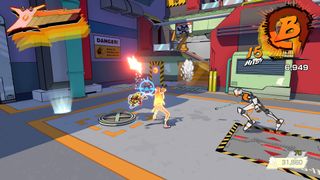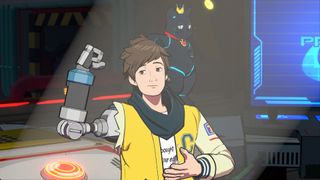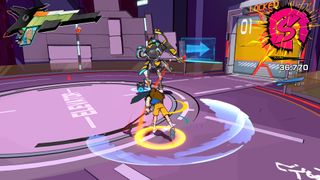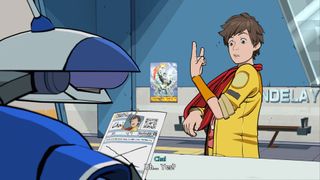It may have been late to the PlayStation party, but the incredible rhythm-based combat and fantastic art direction mean that Hi-Fi Rush is still a wonderful experience over a year since its original release.
Pros
- +
Engaging rhythm-based combat
- +
Beautiful cartoon art direction
- +
Brilliant use of haptic feedback on PS5
Cons
- –
Some repetitive encounters
- –
Humor won’t be for everyone
Why you can trust TechRadar We spend hours testing every product or service we review, so you can be sure you’re buying the best. Find out more about how we test.
Review info
Platform reviewed: PS5
Available on: Xbox Series X|S, PC, PS5
Release date: January 25, 2023; March 19, 2024 (PS5)
Hi-Fi Rush, a rhythm action game that was originally released for Xbox Series X, Xbox Series S, and PC back in January 2023, has finally landed on PlayStation 5 and it’s been worth the wait. With engaging combat mechanics and absolutely beautiful cartoon-like visuals, it’s an absolute blast to play even if a couple of areas in the middle of the game suffer from some repetitive enemy encounters.
Complete with all the post-launch updates from the Xbox and PC versions, which introduced free new cosmetics and modes, not to mention clever use of PS5 exclusive hardware features like enhanced haptic feedback and the speaker of the DualSense Wireless Controller, this PS5 release is the absolute best version of the game yet. As a result, this new release not only nets a glowing recommendation if you haven’t experienced Hi-Fi Rush before, but could also be worth a second look if you haven’t played since launch and want to discover what’s new.
Encore

At the core of Hi-Fi Rush is its brilliant combat system, which seamlessly blends fast-paced third-person melee action with the careful timing of rhythm games like Hatsune Miku: Project Diva or Guitar Hero. After getting an MP3 player stuck inside his chest, everything around aspiring rock star protagonist Chai is synced perfectly in time with the background music. This includes his own animations like his constant finger clicking and a walk cycle that sees his feet hit the floor just in time with the beat, but also the attack animations of the robotic legions that you face.
You battle through each encounter with a fairly standard mix of light attacks, heavy attacks, parries, and dodges, but everything is elevated by one key detail. Attacks deal significantly more damage and flow seamlessly into powerful combos if you tap the button to trigger them just in time with the rhythm. It takes a little bit of getting used to at first, but almost nothing compares to the feeling of satisfaction when you finally manage to get into the flow and find yourself beating robots senseless perfectly in time to the song.
Best bit

One incredible boss fight towards the end of the game sees you face off against a giant robotic wolf while an electronic rock cover of Beethoven’s 5th Symphony blares. It’s an almost transcendental experience and the very first thing that I wanted to replay once I had finished the game.
Mechanics are introduced slowly over the first few stages in an easily digestible format but even if you’re not very experienced when it comes to rhythm games, several well-considered features make it easy to learn the ropes. Most obviously, there’s a large on-screen guide that displays all the upcoming beats and can toggled on or off at any moment with the quick tap of a button. Aside from slightly reduced visibility thanks to its presence on the screen, there’s absolutely no penalty for using this whenever you need it. As each of the 12 stages features a new background song, I found that turning it on for the first few minutes of each one made it much easier to learn the beat.
Chai is also soon joined by a cat-like drone controlled by his companion, Peppermint, which steadily pulses with blue waves at the exact moment you should be hitting your button inputs. There’s also the matter of the background scenery, which also interacts with the music. Set in the sprawling production areas of the futuristic robotics company Vandelay, you’re almost always going to have some steam vent, production line, or flashing moving in time with the beat in view. This is not only a practical addition, but just an incredibly impressive visual effect that perfectly complements the stunningly smooth Saturday morning cartoon art style.
Feel the rhythm

In addition to the combat arenas, stages are punctuated by a varied selection of mechanics. There are traversal puzzles which involve jumping between rhythmically moving platforms, sections where you speed along railing dodging incoming hazards, and even a few moments where the camera is pulled to a side-on view for some 2D platforming. If this wasn’t enough, stages boast their own unique aesthetics to help keep things fresh, ranging from shiny high-tech office buildings to underground volcanic construction sites.
Even in the face of all of this, however, a few stages do start to drag. There’s a great degree of variety in the melee and ranged enemies, but an overreliance on basic sword-wielding grunts in the mid-point of the roughly 12-hour campaign leads to a couple of very samey encounters. It doesn’t massively detract from the overall experience, but it holds Hi-Fi Rush back from perfection.
There’s also the matter of the story, which is conveyed through a seamless blend of lavish hand-drawn animation and subliminally smooth in-game cutscenes. I personally found the frequent fourth wall breaking, self-referential exchanges between Chai and the supporting cast quite charming and often very amusing, but it definitely won’t be for everyone. It’s not nearly as cringeworthy as dialogue from the likes of Borderlands 3 or Saints Row, but it’s in a similar vein.

If that’s up your street then there’s plenty to love here and a fair amount of content to keep you playing after the credits have rolled. On top of a range of collectibles, special challenge rooms hidden across the campaign become unlocked on a second playthrough which, once completed, opens up a special area with even more to tackle. There are also additions like the endless arcade challenge mode, which were added to the Xbox and PC versions after launch but are available here right out of the gate.
Some PS5 exclusive features have been implemented with this release, which are fantastic inclusions too. On top of liberal use of the DualSense’s integrated speaker, which accentuates certain actions with punchy sound effects, haptic feedback has been employed to fantastic effect. With detailed vibration for everything from footsteps in cutscenes to song beats in boss battles, it’s a noticeable step up from playing with an Xbox Wireless Controller.
Hi-Fi Rush may have been a late arrival to the PS5 library, but it’s a brilliant experience that is still worth playing more than a year after its original release. With all of the post-launch content of the other versions, plus some PS5 exclusive additions, there’s never been a better time to get down to the beat.
Accessibility
In addition to its four difficulty settings (easy, normal, hard, and very hard) which can be changed at any point in the game, Hi-Fi Rush features a range of accessibility options. There are multiple subtitle settings for in-game dialogue and cutscenes that can change the text size, background colors, and transparency. There are also colorblind modes for deuteranopia, protanopia, and tritanopia, and options to enable combat assisting features such as automatic parries, and a mode that automatically chooses your attack type.
Should I play Hi-Fi Rush?

Play it if…
You want a unique rhythm-based adventure
A combination of rhythm game mechanics and third-person action, there’s nothing else quite like Hi-Fi Rush. Download a copy if you’re craving a truly one-of-a-kind experience.
You love cartoon aesthetics
The smooth animations and bright, colorful cartoon style means that Hi-Fi Rush is absolutely stunning. It also runs at 60 fps and a 4K resolution on PS5, so looks especially amazing on a big-screen display.
